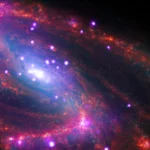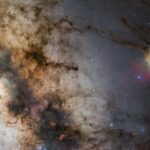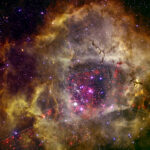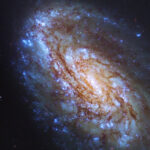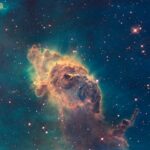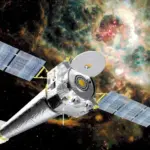This NASA Hubble Space Telescope view of the nearby barred spiral galaxy NGC 1672 unveils details in the galaxy’s star-forming clouds and dark bands of interstellar dust.
One of the most striking features is the dust lanes that extend away from the nucleus and follow the inner edges of the galaxy’s spiral arms. Clusters of hot young blue stars form along the spiral arms and ionize surrounding clouds of hydrogen gas that glow red. Delicate curtains of dust partially obscure and redden the light of the stars behind them by scattering blue light.
Galaxies lying behind NGC 1672 give the illusion they are embedded in the foreground galaxy, even though they are really much farther away. They also appear reddened as they shine through NGC 1672’s dust. A few bright foreground stars inside our own Milky Way Galaxy appear in the image as bright and diamond-like objects.
As a prototypical barred spiral galaxy, NGC 1672 differs from normal spiral galaxies, in that the arms do not twist all the way into the centre. Instead, they are attached to the two ends of a straight bar of stars enclosing the nucleus. Viewed nearly face on, NGC 1672 shows intense star formation regions, especially off in the ends of its central bar.
Astronomers believe that barred spirals have a unique mechanism that channels gas from the disk inward towards the nucleus. This allows the bar portion of the galaxy to serve as an area of new star generation.
NGC 1672 is also classified as a Seyfert galaxy. Seyferts are a subset of galaxies with active nuclei. The energy output of these nuclei can sometimes outshine their host galaxies. This activity is powered by accretion onto supermassive black holes.
NGC 1672 is more than 60 million light-years away in the direction of the southern constellation Dorado. These observations of NGC 1672 were taken with Hubble’s Advanced Camera for Surveys in August 2005. The composite image was made by using filters that isolate light from the blue, green, and infrared portions of the spectrum, as well as emission from ionized hydrogen.









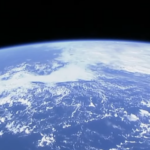
![Space Streams - Nebula [Ambient] image](https://space-streams.com/wp-content/uploads/2024/11/space-streams-nebula-150x150.png)
